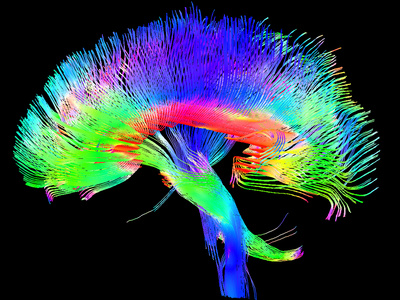From a study by Xiaodan Leng:
The trion model was developed using the Mountcastle organizational principle for the column as the basic neuronal network in the cortex and the physical system analogy of Fisher’s ANNNI spin model. An essential feature is that it is highly structured in time and in spatial connections. Simulations of a network of trions have shown that large numbers of quasi-stable, periodic spatial-temporal firing patterns can be excited. Characteristics of these patterns include the quality of being readily enhanced by only a small change in connection strengths, and that the patterns evolve in certain natural sequences from one to another. With only somewhat different parameters than used for studying memory and pattern recognition, much more flowing and intriguing patterns emerged from the simulations. The results were striking when these probabilistic evolutions were mapped onto pitches and instruments to produce music: For example different simple mappings of the same evolution give music having the “flavor” of a minuet, a waltz, folk music, or styles of specific periods. A theme can be learned so that evolutions have this theme and its variations reoccurring more often. That the trion model is a viable model for the coding of musical structure in human composition and perception is suggested. It is further proposed that model is relevant for examining creativity in the higher cognitive functions of mathematics and chess, which are similar to music. An even higher level of cortical organization was modeled by coupling together several trion networks. Further, one of the crucial features of higher brain function, especially in music composition or appreciation, is the role of emotion and mood as controlled by the many neuromodulators or neuropeptides. The MILA model whose underlying basis is zero-level representation of Kac-Moody algebra is used to modulate periodically the firing threshold of each network. Our preliminary results show that the introduction of “neuromodulation” into the dynamics of a few coupled trion networks greatly enhanced the richness of the music. Neuromodulation plays a very important role in cognitive processes. I discuss many aspects of cognitive processes such as, leaning and memory, innervation of cortical functions and coordination between music and emotions.
What Leng did was to map neuronal firing patterns to pitches, and what comes out sounds like Western classical music. Different mapping patterns produce different “flavours” but all of it is musical.
The implications of this research are staggering. It’s almost impossible to imagine where this might lead, but let me throw out a few ideas.
- Music and Mood: Mood is controlled by neuropeptides. Could listening to music similar to what the brain produces “teach” the brain to release neuropeptides in a way to stabilize mood?
- Music and epilepsy: Could the brain be taught to regularize its firing patterns by listening to music similar to healthy firing patterns?
- Neuromodulation increases the richness of the music produced by the brain: Could listening to the right music enhance our neural firing patterns? Where would that lead: improved memory, higher innovation, higher creativity, better comprehension, better math skills, more interest in life . . .?
And on the other hand, we are subjected to incidental exposure to all kinds of music, and we have to wonder if some of the music we hear is having a detrimental effect on our brain function. We’re all aware of the propagandizing power of music and given this research, it’s now more important than ever that we control what kinds of music we are exposed to.
I’ll be updating this post as more ideas occur to me, and as I get comments from readers . If any reader has access to the full online version of this dissertation please send me the link or post it below. This is the most important post on this blog to date, so please, tell your friends.
